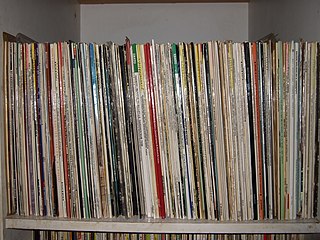
Stamp collecting is the collecting of postage stamps and related objects. It is an area of philately, which is the study of stamps. It has been one of the world's most popular hobbies since the late nineteenth century with the rapid growth of the postal service, as a stream of new stamps was produced by countries that sought to advertise their distinctiveness through their stamps.

An auction is usually a process of buying and selling goods or services by offering them up for bids, taking bids, and then selling the item to the highest bidder or buying the item from the lowest bidder. Some exceptions to this definition exist and are described in the section about different types. The branch of economic theory dealing with auction types and participants' behavior in auctions is called auction theory.

The Inverted Jenny is a 24 cent United States postage stamp first issued on May 10, 1918, in which the image of the Curtiss JN-4 airplane in the center of the design is printed upside-down; it is one of the most famous errors in American philately. Only one pane of 100 of the invert stamps was ever found, making this error one of the most prized in philately.

A textbook is a book containing a comprehensive compilation of content in a branch of study with the intention of explaining it. Textbooks are produced to meet the needs of educators, usually at educational institutions. Schoolbooks are textbooks and other books used in schools. Today, many textbooks are published in both print and digital formats.

Philatelic investment is investment in collectible postage stamps for the purpose of realizing a profit. Philatelic investment was popular during the 1970s but then fell out of favour following a speculative bubble and prices of rare stamps took many years to recover.

A stamp catalog is a catalog of postage stamp types with descriptions and prices.

An online auction is an auction held over the internet and accessed by internet connected devices. Similar to in-person auctions, online auctions come in a variety of types, with different bidding and selling rules.

Record collecting is the hobby of collecting sound recordings, usually of music, but sometimes poetry, reading, historical speeches, and ambient noises. Although the typical focus is on vinyl records, all formats of recorded music can be collected.
Comic book price guides are typically published on a monthly, quarterly, or yearly basis and provide comprehensive information about the fluctuations in the resale value of comics over a specific duration. These guides play a crucial role for collectors who intend to sell their collection or require an estimate of their collection's value for insurance purposes.
Consignment is a process whereby a person gives permission to another party to take care of their property and retains full ownership of the property until the item is sold to the final buyer. It is generally done during auctions, shipping, goods transfer, or putting something up for sale in a consignment store. The owner of the goods pays the third-party a portion of the sale for facilitating the sale. Consignors maintain the rights to their property until the item is sold or abandoned. Many consignment shops and online consignment platforms have a set time limit at which an item's availability for sale expires. Within the time of contract, reductions of the price are common to promote the sale of the item, but vary by the type of item sold.

Auction sniping is the practice, in a timed online auction, of placing a bid likely to exceed the current highest bid as late as possible—usually seconds before the end of the auction—giving other bidders no time to outbid the sniper. This can be done either manually or by software on the bidder's computer, or by an online sniping service.
A catalog merchant is a form of retailing. The typical merchant sells a wide variety of household and personal products, with many emphasizing jewelry. Unlike a self-serve retail store, most of the items are not displayed; customers select the products from printed catalogs in the store and fill out an order form. The order is brought to the sales counter, where a clerk retrieves the items from the warehouse area to a payment and checkout station.

Film memorabilia are objects considered of value because of their connection to the cinema. These include costumes, props, advertising posters, and scripts, among other things. Fans have always coveted memorabilia, but in recent years, what was once a hobby has mushroomed into big business, with millions of dollars changing hands in auctions held by such top firms as Christie's and Sotheby's. In addition, many popular films have their collectible items sold via independent, online movie memorabilia stores, web auctions, and at film studio charity events.

A multiunit auction is an auction in which several homogeneous items are sold. The units can be sold each at the same price or at different prices.

A white elephant sale is a collection of used items being sold, much akin to a yard sale or garage sale, often as a fund-raiser for a cause.
Customer to customer markets provide a way to allow customers to interact with each other. Traditional markets require business to customer relationships, in which a customer goes to the business in order to purchase a product or service. In customer to customer markets, the business facilitates an environment where customers can sell goods or services to each other. Other types of markets include business to business (B2B) and business to customer (B2C).

Pricefalls, LLC was an American Internet company that managed Pricefalls.com, an on-line retail marketplace, and PFTech, a leading marketplace platform developer. In 2019, Pricefalls, LLC was acquired by Loblaw, Canada's largest retailer.

Worthy.com is an online liquidation marketplace for pre-owned luxury goods including diamonds, brand-named watches, and diamond jewelry. Worthy is headquartered in New York City and was founded by investment banker Ben De-Kalo in 2014.

The art market is the marketplace of buyers and sellers trading in commodities, services, and works of art.
Leopoldo Franciolini (1844–1920) was an Italian antique dealer who was active in the late 19th and early 20th centuries. He is remembered as a fraudster who sold faked and altered historical musical instruments. To this day his work is a barrier to the scholarly study of instruments of the past.












